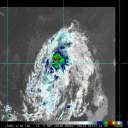Show Selection:
|
#932165 (Received by flhurricane at: 11:00 AM 09.Jul.2018)
TCDAT3
Tropical Storm Chris Discussion Number 12
NWS National Hurricane Center Miami FL AL032018
1100 AM EDT Mon Jul 09 2018
A NOAA reconnaissance aircraft investigating Chris this morning has
found little change in the overall structure of the cyclone. The
peak 8000-ft wind measured was 60 kt to the south of the center
along with a 51-kt SFMR surface wind. The minimum pressure has also
remained steady at 999 mb during the entire mission which is still
ongoing. Although an eye-like feature has briefly appeared in
WSR-88D Doppler radar data from Morehead City and in satellite
imagery as well, the convection surrounding that feature has been
mostly shallow and ragged. Based on these data, the intensity
remains at 50 kt for this advisory.
Air Force and NOAA reconnaissance fixes the past several hours and
satellite fixes indicate that Chris has moved little. Steering
currents are forecast to remain weak for the next 24 hours or so,
resulting in continued slow movement. By 36 hours, however, a
shortwave trough is forecast to dig southeastward out of Canada and
into the northeastern U.S. and mid-Atlantic states, which should
help to eject the cyclone northeastward. By 48 hours and beyond, the
shortwave trough will help to amplify a deep-layer trough near the
U.S. east coast, causing Chris to accelerate northeastward toward
the Atlantic Canada region. The NHC model guidance continues to show
little cross-track differences, but fairly significant along-track
or speed differences. As a result, the official forecast track
remains close to the consensus track models.
A narrow band of dry mid-level air has wrapped all the way around
and into the inner-core region, which has caused some erosion of the
associated convection, along with some upwelling. However, the
reconnaissance wind data indicated that Chris has a relatively small
radius of maximum winds (RMW) of 15 nmi to the south and about 25
nmi to the north. This well-defined inner-core wind field, coupled
with warm water and low vertical shear conditions, should enable the
cyclone to mix out the dry air later today and tonight, which will
allow for strengthening to begin. The intensification process should
be steady at a near-normal rate for the next 36 hours or so,
followed by gradual weakening in a few days as the waters beneath
Chris begin to cool and the wind shear increases from the southwest.
By 72 hours and beyond, Chris will be over much colder water (SSTs
less than 20 deg C) and within a high shear environment of 30 kt or
more, which will induce a rapid transition to a powerful
extratropical cyclone as the system approaches Newfoundland. The
extratropical low is forecast to interact or merge with a strong
cold front by 96 hours when the cyclone is near Newfoundland, which
will enhance the extratropical transition process. The new intensity
forecast is similar to the previous advisory and shows Chris
reaching hurricane strength by Tuesday. Chris could reach a peak
intensity of 80 kt between the 36 and 48 hour time periods before
weakening begins shortly thereafter.
FORECAST POSITIONS AND MAX WINDS
INIT 09/1500Z 32.2N 74.5W 50 KT 60 MPH
12H 10/0000Z 32.3N 74.4W 55 KT 65 MPH
24H 10/1200Z 32.4N 74.3W 65 KT 75 MPH
36H 11/0000Z 33.3N 73.0W 75 KT 85 MPH
48H 11/1200Z 34.8N 70.9W 75 KT 85 MPH
72H 12/1200Z 40.5N 64.0W 70 KT 80 MPH
96H 13/1200Z 47.0N 55.5W 50 KT 60 MPH...POST-TROP/EXTRATROP
120H 14/1200Z 51.1N 41.0W 35 KT 40 MPH...POST-TROP/EXTRATROP
$$
Forecaster Stewart |



